I am trying to solve this problem. And I can individually do
(i)P LEFT JOIN Q ON P.A = Q.A AND P.B = Q.B
and
(ii) Q RIGHT JOIN R ON Q.A = R.A But to JOIN the results of these two, I'm not able to find an answer. Though this answer came little close SQL Join two query results
With this, I tried the following and got an ambiguous error. I know I can alias columns but once again failed to find how to create an alias for column names on the FROM clause.
mysql> with r1 as (select * from p left join q on p.a = q.a and p.b = q.b) select * from q right join r on q.a = r.a cross join r1 on r1.a = r.e;
ERROR 1060 (42S21): Duplicate column name 'a'
Is there an elegant way of creating two "WITH" clauses for two results and then joining the two results or can it be done even much more simpler than that?
EDIT: To avoid ambiguity I tried aliasing all fields and found that it is working. But also will try other answer that is provided by Impaler.
mysql> with r1 as (select p.a as pa, p.b as pb, p.c as pc, q.a as qa, q.b as qb, q.d as qd from p left join q on p.a = q.a and p.b = q.b), r2 as (select q.a as qa1, q.b as qb1, q.d as qd1, r.a as ra1, r.e as re1 from q right join r on q.a = r.a) select * from r1 cross join r2;
+------+------+------+------+------+------+------+------+------+------+------+
| pa | pb | pc | qa | qb | qd | qa1 | qb1 | qd1 | ra1 | re1 |
+------+------+------+------+------+------+------+------+------+------+------+
| a3 | b2 | c2 | NULL | NULL | NULL | a1 | b2 | 2 | a1 | e1 |
| a3 | b3 | c1 | NULL | NULL | NULL | a1 | b2 | 2 | a1 | e1 |
| a2 | b1 | c2 | a2 | b1 | 5 | a1 | b2 | 2 | a1 | e1 |
| a1 | b2 | c1 | a1 | b2 | 2 | a1 | b2 | 2 | a1 | e1 |
| a3 | b2 | c2 | NULL | NULL | NULL | a3 | b1 | 6 | a3 | e2 |
| a3 | b3 | c1 | NULL | NULL | NULL | a3 | b1 | 6 | a3 | e2 |
| a2 | b1 | c2 | a2 | b1 | 5 | a3 | b1 | 6 | a3 | e2 |
| a1 | b2 | c1 | a1 | b2 | 2 | a3 | b1 | 6 | a3 | e2 |
| a3 | b2 | c2 | NULL | NULL | NULL | NULL | NULL | NULL | a4 | e3 |
| a3 | b3 | c1 | NULL | NULL | NULL | NULL | NULL | NULL | a4 | e3 |
| a2 | b1 | c2 | a2 | b1 | 5 | NULL | NULL | NULL | a4 | e3 |
| a1 | b2 | c1 | a1 | b2 | 2 | NULL | NULL | NULL | a4 | e3 |
| a3 | b2 | c2 | NULL | NULL | NULL | NULL | NULL | NULL | a4 | NULL |
| a3 | b3 | c1 | NULL | NULL | NULL | NULL | NULL | NULL | a4 | NULL |
| a2 | b1 | c2 | a2 | b1 | 5 | NULL | NULL | NULL | a4 | NULL |
| a1 | b2 | c1 | a1 | b2 | 2 | NULL | NULL | NULL | a4 | NULL |
+------+------+------+------+------+------+------+------+------+------+------+
